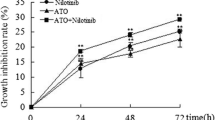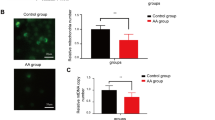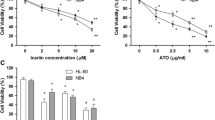Abstract
Objective
Acute myeloid leukemia progressed from myelodysplastic syndrome (MDS/AML) is generally incurable with poor prognosis for complex karyotype including monosomy 7 (-7). Qinghuang Powder (青黄散, QHP), which includes Qing Dai (Indigo naturalis) and Xiong Huang (realgar) in the formula, is effective in treating MDS or MDS/AML even with the unfavorable karyotype, and its therapeutic efficacy could be enhanced by increasing the Xiong huang content in the formula, while Xiong huang contains > 90% arsenic disulfide (As2S2). F-36p cell line was established from a MDS/AML patient with complex karyotype including -7, and was in cytokine-dependent. The present study was to investigate the effects of As2S2 on F-36p cells.
Methods
Cell proliferation was measured by an 3-(4,5-dimethylthiazol-2-yl)-2, 5-diphenyltetrazolium bromide (MTT) assay. Cell apoptosis was identified by Annexin V-staining. Cell viability was determined by a propidium iodide (PI) exclusion. Erythroid differentiation was evaluated by the expression of cell surface antigen CD235a (GpA).
Results
After treatment with As2S2 at concentrations of 0.5 to 16 μmol/L for 72 h, As2S2 inhibited the proliferation of F-36p cells. The 50% inhibitory concentrations (IC50) of As2S2 against the proliferation of F-36p cells was 6 μmol/L. The apoptotic cells significantly increased in a dose-dependent mannar (P<0.05). The cell viabilities were significantly inhibited by As2S2 dose-dependent in a dose-dependent manner (P<0.05). Significant increases of CD235a-positive cells were concurrently observed (P<0.05) also in a dose-dependent manner.
Conclusions
As2S2 could inhibit proliferation and viability, induce apoptosis, and concurrently promote erythroid differentiation dose-dependently in F-36p cells. As2S2 can inhibit proliferation and viability, induce apoptosis, and concurrently promote erythroid differentiation in cytokine-dependent MDS-progressed human leukemia cell line F-36p with complex karyotype including -7. The data suggest that QHP and/or As2S2 could be a potential candidate in the treatment of MDS or MDS/AML even with unfavorable cytogenetics.
Similar content being viewed by others
References
Hu XM, Tang XD, Ma R, Yang YM. Pathogenesis of myelodysplastic syndrome. Int J Blood Transfusion Hematol (Chin) 2006;29:132–136.
Greenberg P, Cox C, LeBeau MM, Fenaux P, Morel P, Sanz G, et al. International coring system for evaluating prognosis in myelodysplastic syndromes. Blood 1997;89:2079–2088.
Shi J, Shao ZH, Liu H, Bai J, Cao YR, He GS, et al. Transformation of myelodysplastic syndromes into acute myeloid leukemias. Chin Med J 2004;117:963–967.
Grimwade D, Walker H, Oliver F, Wheatley K, Harrison C, Harrison G, et al. The importance of diagnostic cytogenetics on outcome in AML: analysis of 1612 patients entered into the MRC AML 10 trial. Blood 1998;92:2322–2333.
Kobayashi H, Matsuyama T, Ueda M. Predictive factors of response and survival following chemotherapy treatment in acute myeloid leukemia progression from myelodysplastic syndrome. Int Med 2009;48:1629–1633.
Hu XM, Wang HZ, Mao C, Liu C, Li L, Zheng CM, et al. Clinical significance of trisomy 8 and monosomy 7/7q deletion in myelodysplastic syndrome. J Clin Hematol (Chin) 2006;19:340–343.
Hu XM, Liu F, Zheng CM, Li L, Liu C, Zhang SS, et al. Effect and prognosis analysis of teatmentfor acute myeloid leukemia using Chinese drugs combined with chemotherapy. Chin J Integr Med 2009;15:193–197.
Hu XM, Yang XH, Wang HZ, Xu YG, Liu C, Xiao HY, et al. Clinical significance of CD7 expression in associated with cytogenetics in acute myeloid leukaemia. J Clin Hematol (Chin) 2009;22:2–5.
Emadi A, Gore SD. Arsenic trioxide—An old drug rediscovered. Blood Rev 2010;24:191–199.
Hu XM, Liu F, Ma R. Application and assessment of Chinese arsenic drugs in treating malignant hematopathy in China. Chin J Integr Med 2010;16:368–377.
Hu XM, Ma L, Hu NP, Wang HZ, Liu C, Wang ZF, et al. Ai-Lin I (As2O3) treated 62 cases of acute promyelocytic leukemia. Chin J Integr Tradit West Med (Chin) 1999;19:473–476.
Wang ZY, Chen Z. Acute promyelocytic leukemia: from highly fatal to highly curable. Blood 2008;111:2505–2515.
Kim JH, Kim JH, Yu YS, Kim DH, Kim CJ, Kim KW. Antitumor activity of arsenic trioxide on retinoblastoma: cell differentiation and apoptosis depending on arsenic trioxide concentration. Investig Ophthalmol Visual Sci 2009:50:1819–1823.
Hu XM, Hirano T, Oka K. Arsenic trioxide induces apoptosis equally in T lymphoblastoid leukemia MOLT-4 cells and P-gp-expressing daunorubicin-resistant MOLT-4 cells. Cancer Chemother Pharmacol 2003:52:119–126.
Hu XM, Hirano T, Oka K. Arsenic trioxide induces apoptosis in cells of MOLT-4 and its daunorubicin-resistant cell line via depletion of intracellular glutathione, disruption of mitochondrial membrane potential and activation of caspase-3. Cancer Chemother Pharmacol 2003;52:47–58.
Gan G, Sun J, Wang JY, Wang Y. Analysis of 27 cases on serious adverse drug reaction induced by arsenic trioxide. Chin J Pharmacovigilance (Chin) 2008:5:286–290.
Cohen SM, Arnold LL, Eldan M, Lewis AS, Beck BD. Methylated arsenicals: the implications of metabolism and carcinogenicity studies in rodents to human risk assessment. Crit Rev Toxicol 2006;36:99–133.
State Pharmacopoeia Commission. Chinese Pharmacopoeia. Part 1. 2010 ed. Beijing: Chinese Medical Science and Technology Press.
Hu XM, Ma R, Xu YG, Guo XQ, Xu S, Liu F, et al. Treatment of hematologic malignancies with Qinghuang Powder. Int J Tradit Chin Med (Chin) 2011;33:568–570.
Zhou AX, Chen ZW, Ma R, Deng CS, Liu F, Hu XM, et al. Clinical investigation of treatment with Qinghuang Powder in 86 patients with chronic myelogenus leukemia. J Leukemia Lymphoma (Chin) 2010;19:655–657.
Wang ZX, Zhou AX, Yang L, Yang JM, Hu NP, Wang ZF, et al. Long-term survival more than 10 years of patients with chronic myelocytic leukemia treated with Qinghuang Powder: a report of 6 cases. J Leukemia (Chin) 1998;7:93–94.
Xu S, Ma R, Hu XM, Xu YG, Yang XH, Wang HZ, et al. Clinical observation on Qinghuang Powder for treatment of 31 cases of myelodysplastic syndrome. J Tradit Chin Med (Chin) 2006;47:514–516.
Xu S, Hu XM, Xu YG, Yang XH, Wang HZ, Liu F, et al. Effect of treatment for myelodysplastic syndrome by Qinghuang Powder combined with Chinese herbs for reinforcing Shen and strenghening Pi. Chin J Integr Tradit West Med (Chin) 2008;28:216–219.
Xu S, Ma R, Hu XM, Xu, YG, Yang XH, Wang HZ, et al. Clinical observation of the treatment of myelodysplastic syndrome mainly with Qinghuang Powder. Chin J Integr Med 2011;17:834–839.
Liu F, Guo XQ, Hu XM, Wang HZ, Xu YG, Yang XH, et al. Effect of Qinghuang Powder in treating 36 patients with myelodysplastic syndrome. J Tradit Chin Med (Chin) 2011;52:241–242.
Guo XQ, Liu F. Effect of Qinghuang Powder in treating two patients with acute erythroid leukemia progressed from MDS. J Tradit Chin Med (Chin) 2009;50:75–758.
Chiba S, Fakaku F, Tange T, Shibuya K, Misawa C, Sasaki K, et al. Establishment and erythroid differentiation of a cytokine-dependent human leukemic cell line F-36: a parental line requiring granulocyte-macrophage colony-stimulating factor or interleukin-3, and a subline requiring erythropoietin. Blood 1991;178:2261–2268.
Larson RA. Is secondary leukemia an independent poor prognostic factor in acute myeloid leukemia? Best Pract Res Clin Haematol 2007;20:29–37.
Hofmann WK, Heil G, Zander C, Wiebe S, Ottmann OG, Bergmann L, et al. Intensive chemotherapy with idarubicin, cytarabine, etoposide, and G-CSF priming in patients with advanced myelodysplastic syndrome and high-risk acute myeloid leukemia. Ann Hematol 2004;83:498–503.
Platzbecker U, Hofbauer LC, Ehninger G, Hŏlig K. The clinical, quality of life, and economic consequences of chronic anemia and transfusion support in patients with myelodysplastic syndromes. Leukemia Res 2012;36:525–536.
Alessandrino EP, Amadori S, Barosi G, Cazzola M, Grossi A, Liberato LN, et al. Evidence- and consensus-based practice guidelines for the therapy of primary myelodysplastic syndromes. A statement from the Italian Society of Hematology. Haematologica 2002; 87:1286–1306.
Terpos E, Mougiou A, Kouraklis A, Chatzivassili A, Michalis E, Giannakoulas N, et al. Prolonged administration of erythropoietin increases erythroid response rate in myelodysplastic syndromes: A phase II trial in 281 patients. Br J Haematol 2002;118:174–180.
Spiriti MA, Latagliata R, Niscola P, Cortelezzi A, Francesconi M, Ferrari D, et al. Impact of a new dosing regimen of epoetin alfa on quality of life and anemia in patients with low-risk myelodysplastic syndrome. Ann Hematol 2005;84:167–176.
Yoon MJ, Lee HJ, Kim JH, Kim DK. Extracellular ATP induces apoptotic signaling in human monocyte leukemic cells, HL-60 and F-36P. Arch Pharmacol Res 2006;29:1032–1041.
Matsumura I, Kitamura T, Wakao H, Tanaka H, Hashimoto K, Albanese C, et al. Transcriptional regulation of the cyclin D1 promoter by STAT5: its involvement in cytokine-dependent growth of hematopoietic cells. J Eur Mol Biol Organ 1999;18:1367–1377.
Okutani Y, Kitanaka A, Tanaka T, Kamano H, Ohnishi H, Kubota Y, et al. Src directly tyrosine-phosphorylates STAT5 on its activation site and is involved in erythropoietin-induced signaling pathway. Oncogene 2001;20:6643–6650.
Kubota Y, Tanaka T, Kitanaka A, Ohnishi H, Okutani Y, Waki M, et al. Src transduces erythropoietin-induced differentiation signals through phosphatidylinositol 3-kinase. J Eur Mol Biol Organ 2001;20:5666–5677.
Author information
Authors and Affiliations
Corresponding author
Additional information
Supported in part by grants from Japan China Medical Association to Bo Yuan and XiaoMei Hu
Rights and permissions
About this article
Cite this article
Hu, Xm., Tanaka, S., Onda, K. et al. Arsenic disulfide induced apoptosis and concurrently promoted erythroid differentiation in cytokine-dependent myelodysplastic syndrome-progressed leukemia cell line F-36p with complex karyotype including monosomy 7. Chin. J. Integr. Med. 20, 387–393 (2014). https://doi.org/10.1007/s11655-013-1514-7
Received:
Published:
Issue Date:
DOI: https://doi.org/10.1007/s11655-013-1514-7




